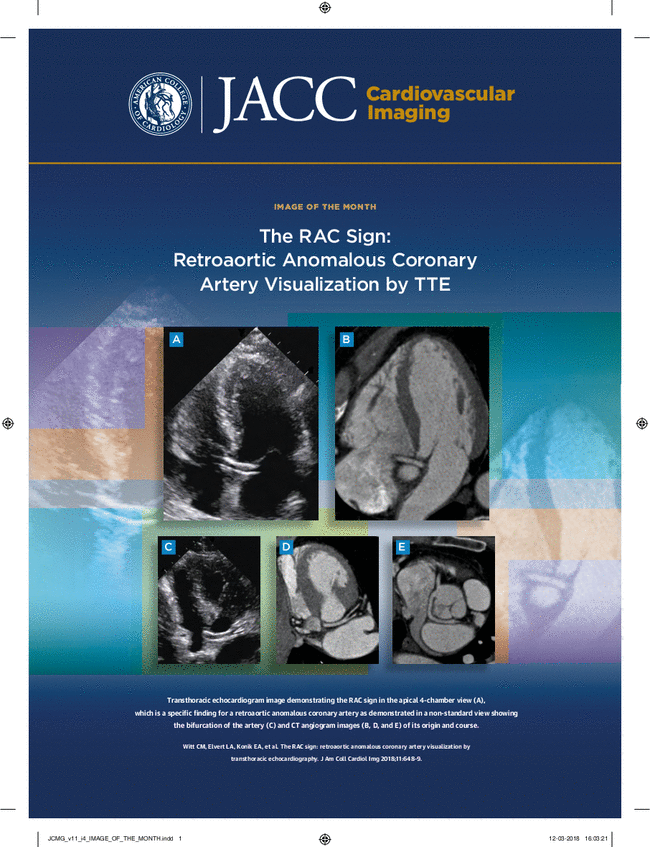Myocardial Blood Flow Quantification Using Stress Cardiac Magnetic Resonance Improves Detection of Coronary Artery Disease
IF 12.8
1区 医学
Q1 CARDIAC & CARDIOVASCULAR SYSTEMS
引用次数: 0
Abstract
Background
Myocardial blood flow (MBF) and myocardial perfusion reserve (MPR) using stress cardiovascular magnetic resonance (CMR) have been shown to identify epicardial coronary artery disease. However, comparative analysis between quantitative perfusion and conventional qualitative assessment (QA) remains limited.
Objectives
The aim of this multicenter study was to test the hypothesis that quantitative stress MBF (sMBF) and MPR analysis can identify obstructive coronary artery disease (obCAD) with comparable performance as QA of stress CMR performed by experienced physicians in interpretation.
Methods
The analysis included 127 individuals (mean age 62 ± 16 years, 84 men [67%]) who underwent stress CMR. obCAD was defined as the presence of stenosis ≥50% in the left main coronary artery or ≥70% in a major vessel. Each patient, coronary territory, and myocardial segment was categorized as having either obCAD or no obCAD (noCAD). Global, per coronary territory, and segmental MBF and MPR values were calculated. QA was performed by 4 CMR experts.
Results
At the patient level, global sMBF and MPR were significantly lower in subjects with obCAD than in those with noCAD, with median values of sMBF of 1.5 mL/g/min (Q1-Q3: 1.2-1.8 mL/g/min) vs 2.4 mL/g/min (Q1-Q3: 2.1-2.7 mL/g/min) (P < 0.001) and median values of MPR of 1.3 (Q1-Q3: 1.0-1.6) vs 2.1 (Q1-Q3: 1.6-2.7) (P < 0.001). At the coronary artery level, sMBF and MPR were also significantly lower in vessels with obCAD compared with those with noCAD. Global sMBF and MPR had areas under the curve (AUCs) of 0.90 (95% CI: 0.84-0.96) and 0.86 (95% CI: 0.80-0.93). The AUCs for QA by 4 physicians ranged between 0.69 and 0.88. The AUC for global sMBF and MPR was significantly better than the average AUC for QA.
Conclusions
This study demonstrates that sMBF and MPR using dual-sequence stress CMR can identify obCAD more accurately than qualitative analysis by experienced CMR readers.
利用负荷心脏磁共振进行心肌血流定量可提高冠状动脉疾病的检测率
背景:使用应激心血管磁共振(CMR)检查心肌血流(MBF)和心肌灌注储备(MPR)已被证明可识别心外膜冠状动脉疾病。然而,定量灌注与传统定性评估(QA)之间的比较分析仍然有限:这项多中心研究的目的是验证一个假设,即定量应激 MBF(sMBF)和 MPR 分析可识别阻塞性冠状动脉疾病(obCAD),其性能与经验丰富的医生进行的应激 CMR 定量分析的定性分析相当:阻塞性冠状动脉疾病的定义是左冠状动脉主干狭窄≥50%或主干血管狭窄≥70%。每位患者、每个冠状动脉区域和每个心肌节段都被分为有 obCAD 或无 obCAD(noCAD)。计算总体、每个冠状动脉区域和节段的 MBF 和 MPR 值。由 4 位 CMR 专家进行质量评估:结果:在患者层面,obCAD 患者的整体 sMBF 和 MPR 明显低于无 obCAD 患者,sMBF 的中位值为 1.5 mL/g/min(Q1-Q3:1.2-1.8 mL/g/min) vs 2.4 mL/g/min (Q1-Q3: 2.1-2.7 mL/g/min) (P < 0.001),MPR 中位值为 1.3 (Q1-Q3: 1.0-1.6) vs 2.1 (Q1-Q3: 1.6-2.7) (P < 0.001)。在冠状动脉层面,obCAD血管的sMBF和MPR也明显低于无obCAD血管。全球 sMBF 和 MPR 的曲线下面积 (AUC) 分别为 0.90(95% CI:0.84-0.96)和 0.86(95% CI:0.80-0.93)。由 4 名医生进行 QA 的 AUC 在 0.69 和 0.88 之间。全球 sMBF 和 MPR 的 AUC 明显优于 QA 的平均 AUC:本研究表明,与经验丰富的 CMR 阅读器的定性分析相比,使用双序列应力 CMR 的 sMBF 和 MPR 能更准确地识别 obCAD。
本文章由计算机程序翻译,如有差异,请以英文原文为准。
求助全文
约1分钟内获得全文
求助全文
来源期刊

JACC. Cardiovascular imaging
CARDIAC & CARDIOVASCULAR SYSTEMS-RADIOLOGY, NUCLEAR MEDICINE & MEDICAL IMAGING
CiteScore
24.90
自引率
5.70%
发文量
330
审稿时长
4-8 weeks
期刊介绍:
JACC: Cardiovascular Imaging, part of the prestigious Journal of the American College of Cardiology (JACC) family, offers readers a comprehensive perspective on all aspects of cardiovascular imaging. This specialist journal covers original clinical research on both non-invasive and invasive imaging techniques, including echocardiography, CT, CMR, nuclear, optical imaging, and cine-angiography.
JACC. Cardiovascular imaging highlights advances in basic science and molecular imaging that are expected to significantly impact clinical practice in the next decade. This influence encompasses improvements in diagnostic performance, enhanced understanding of the pathogenetic basis of diseases, and advancements in therapy.
In addition to cutting-edge research,the content of JACC: Cardiovascular Imaging emphasizes practical aspects for the practicing cardiologist, including advocacy and practice management.The journal also features state-of-the-art reviews, ensuring a well-rounded and insightful resource for professionals in the field of cardiovascular imaging.
 求助内容:
求助内容: 应助结果提醒方式:
应助结果提醒方式:


